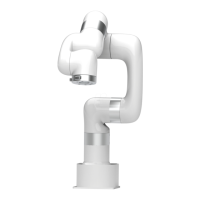
Do you have a question about the UFactory LITE 6 and is the answer not in the manual?
Overview of safety information and user responsibilities.
Explains warning icons (DANGER, WARNING, NOTICE, CAUTION) and their meanings.
General warnings and cautions for installation and planning.
Lists general warnings and cautions for operation.
Provides safety guidelines for robot operators.
Details the function and operation of the emergency stop button.
Safety recommendations for installing the robot in its environment.
Ensures network cable connection and workspace clearance before powering.
Steps to power on and shut down the robot using UFACTORY Studio.
Warnings and cautions for electrical connections and maintenance.
Details dedicated safety inputs and their configurations.
Compares Emergency Stop and Protective Stop input functions.
Ensures hardware is installed and protective measures are in place.
Guides on connecting the robot via various network settings.
Discusses four network setting methods for connecting the robot.
Steps for configuring the robot's IP address.
Accessing UFACTORY Studio via IP address in a browser.
Overview of the Studio homepage interface and parameters.
Displays robot state, IP, payload, and other parameters.
Interface for configuring robotic arm parameters.
Interface for adjusting motion parameters like speed and acceleration.
Adjusts acceleration, position step, and attitude step for linear motion.
Adjusts acceleration and step length for joint motion.
Configures collision and teach sensitivity levels.
Steps to set the robot's initial safe position.
Interface for selecting and configuring installed end effectors.
How to select installed end effectors like Gripper or Vacuum Gripper.
Interface for managing TCP payload and offset settings.
Defines load weight and center of gravity for TCP.
Sets tool coordinate offset relative to flange center.
Setting, creating, selecting, deleting, and saving TCP payload data.
Manual input or automatic identification for TCP payload.
Interface for managing TCP offset records.
Interface for configuring safety-related settings.
Limits the robot's working range in Cartesian space.
Limits maximum linear speed, joint speed, and joint range.
Informs control box of robot's mounting relationship to gravity.
Interface for managing coordinate systems.
Setting coordinate offset to customize user coordinate system.
Manually inputting base coordinate offset parameters.
Teaching the base coordinate offset parameter.
Adjusting robot arm rotation via axis-angle or R/P/Y.
Quickly adjusting parameters via interface and button.
Unlocking individual joints for manual rotation.
Immediate stop of motion and clearing of cached commands.
Enables free joint movement by hand for teaching.
Interface for controlling individual joint movements.
Setting step angles for joint motion.
Interface for controlling linear motion in Cartesian space.
Straight line motion in Cartesian space, speed not continuous.
Defines the default TCP coordinate system and its orientation.
Interface for adjusting robot operating speeds.
Setting joint speed from 1°/s to 180°/s.
Setting Cartesian speed from 1mm/s to 1000mm/s.
Explains project creation, import, download, and simulation views.
Drag and drop code blocks, reset view to default.
Commands for robot motion like sleep, stop, and zero position.
Immediately stops robot and clears command cache.
Sets joint values for movement, with wait/edit options.
Sets Cartesian target and rotation angle with wait/edit.
Creating projects, files, folders, renaming, deleting, and running files.
Controls for recording, manual mode, time display, playback times/speed.
Point-to-point motion in joint space, speed not continuous.
Sets joint angles with parameters for servo ID, angle, speed, acceleration.
Planning continuous motion using arc transitions between joint commands.
Sets arc radius for smooth transitions in joint motion.
Control of linear and arc linear motion in Cartesian space.
Straight line motion in Cartesian space, speed not continuous.
Commands for setting TCP speed, acceleration, and position.
Planning continuous motion using arc transitions between straight lines.
Sets arc radius for transitions; Radius>0 for continuous motion.
Planning circular and arc trajectories.
Calculates spatial circle trajectory using three points.
Setting the center angle for circular or arc paths.
Defines circle path using current position, pose1, pose2, and center angle.